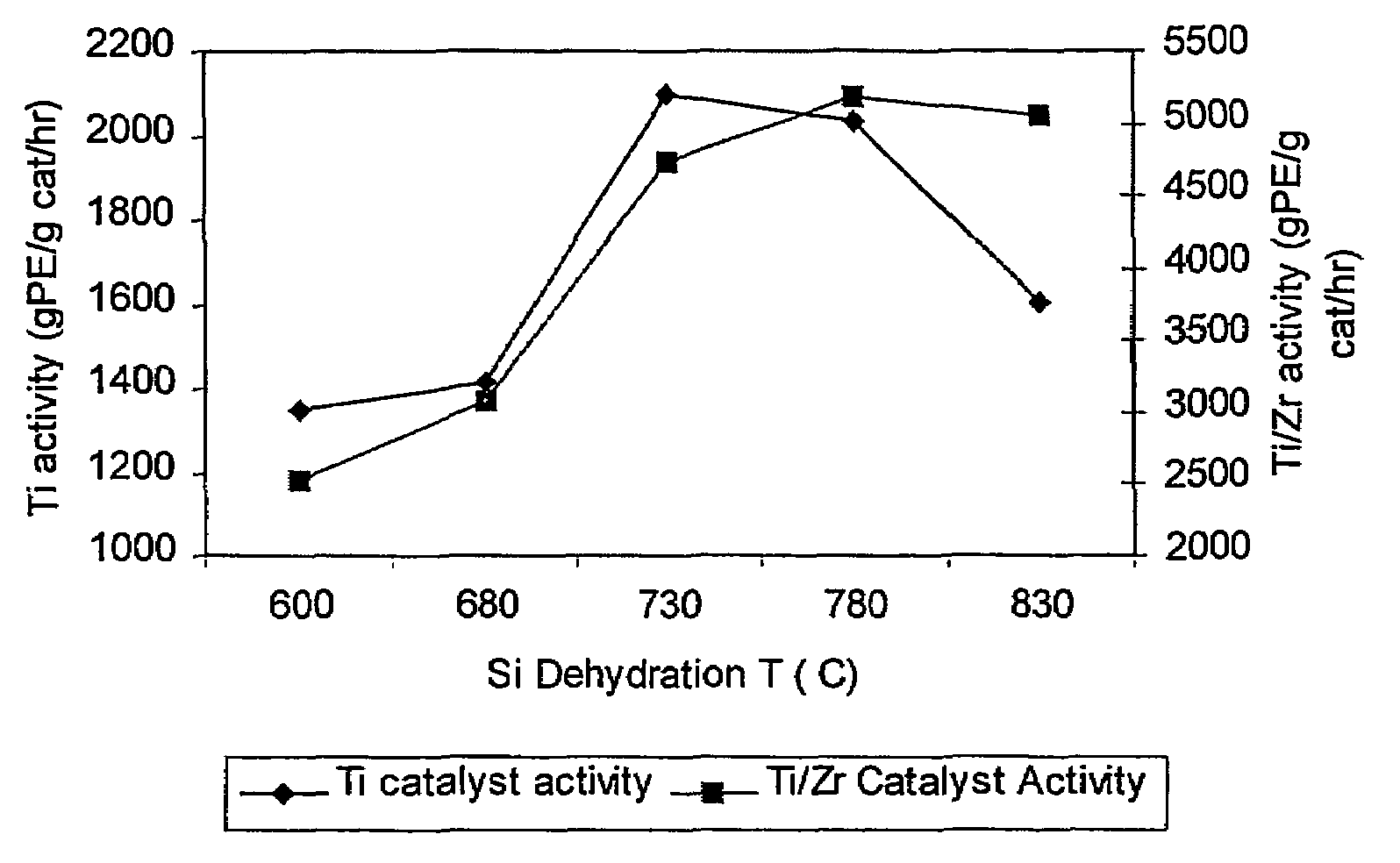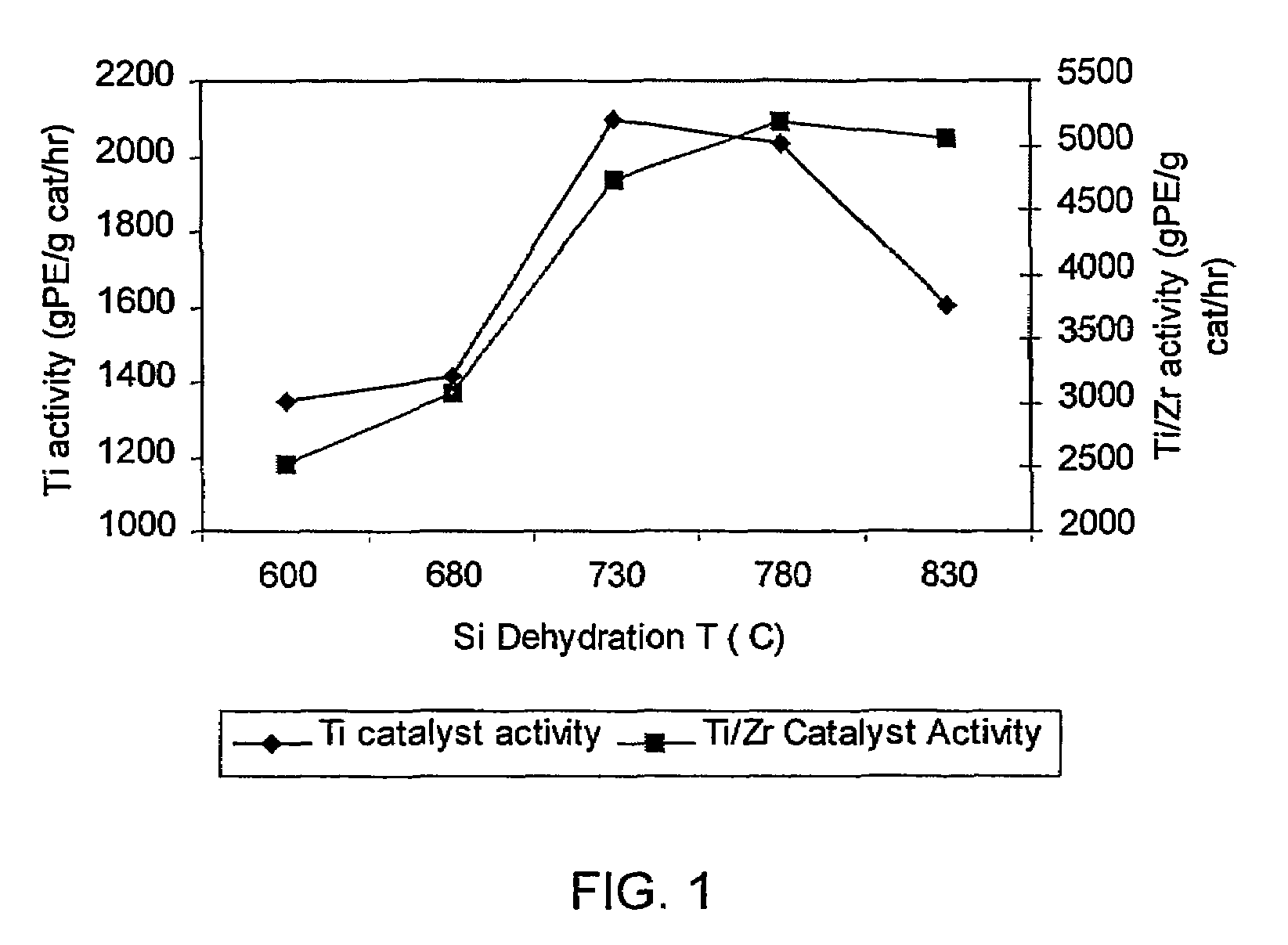Method of making a bimetallic catalyst with higher activity
a bimetallic catalyst and higher activity technology, applied in the field of bimetallic catalyst production, can solve the problem of undesirable low activity of known bimetallic catalysts, and achieve the effect of increasing activity
- Summary
- Abstract
- Description
- Claims
- Application Information
AI Technical Summary
Problems solved by technology
Method used
Image
Examples
example 1
[0140]This example shows that the activity of the supported non-metallocene transition metal catalyst is increased when the support material used to prepare the catalyst is dehydrated at a higher temperature than is conventionally used. Two samples of Davison 955 silica were dehydrated, one at a temperature of 600° C. (Sample 1A) and one at a temperature of 850° C. (Sample 1B). The dehydrated silicas were then treated with dibutylmagnesium (0.72 mmol / g silica), butanol, and titanium tetrachloride as described above, to yield a supported non-metallocene transition metal catalyst. This catalyst was then used in a laboratory slurry reactor to polymerize ethylene, and the catalyst activity was determined for each sample. Sample 1A (using 600° C. dehydrated silica) showed an activity of 3900 grams polyethylene per gram catalyst per hour, and Sample 1B (using 850° C. dehydrated silica) showed an activity of 4960 grams polyethylene per gram catalyst per hour.
example 2
[0141]Two non-metallocene transition metal catalysts were prepared. Samples of Davison 955 silica were dehydrated under nitrogen flow for 4 hours at 600° C. (Sample 2A) and at 800° C. (Sample 2B). Each sample was then treated as follows. 4.00 g of the dehydrated silica was placed into a Schlenk flask with 100 mL hexane. The flask was placed into an oil bath at about 50° C., with stirring. Dibutylmagnesium (2.88 mmol) was added via syringe to the stirred slurry at about 50° C. and the slurry was stirred at this temperature for 1 hour. 2.96 mmol of n-butanol was added via syringe to the stirred mixture at about 50° C. and the mixture was stirred at this temperature for 1 hour. Finally, 1.728 mmol of TiCl4 was added via syringe to the mixture at about 50° C. and stirring continued for 1 hour. Then, the liquid phase was removed under nitrogen flow at about 50° C. to yield a free-flowing powder.
[0142]Ethylene / 1-hexene copolymers were prepared using the two samples. A 2.0 L stainless stee...
example 3
[0144]Two samples of bimetallic catalysts were prepared. First, non-metallocene catalysts were prepared using 600° C. dehydrated silica (Sample 3A) and 800° C. dehydrated silica (Sample 3B) as in Example 2. Each sample was then treated as follows. The dried non-metallocene catalyst was reslurried in hexane (5 mL per gram of catalyst) at ambient temperature, with stirring. To this stirred slurry was slowly added a solution of the reaction product of 30 wt % MAO in toluene (6.8 mmol Al / g non-metallocene catalyst) and bis(n-butylcyclopentadienyl)zirconium dichloride (Al / Zr molar ratio 100:1). The dark brown mixture was stirred at ambient temperature for 1 hour and then heated to about 45° C. The liquid phase was then removed under nitrogen flow to yield a free-flowing brown powder.
[0145]The two bimetallic catalyst samples were then used to polymerize ethylene / 1-hexene as described in Example 2. The bimetallic catalyst prepared with 600° C. dehydrated silica (Sample 3A) had an activity ...
PUM
| Property | Measurement | Unit |
|---|---|---|
| temperature | aaaaa | aaaaa |
| temperature | aaaaa | aaaaa |
| temperature | aaaaa | aaaaa |
Abstract
Description
Claims
Application Information
 Login to View More
Login to View More - R&D
- Intellectual Property
- Life Sciences
- Materials
- Tech Scout
- Unparalleled Data Quality
- Higher Quality Content
- 60% Fewer Hallucinations
Browse by: Latest US Patents, China's latest patents, Technical Efficacy Thesaurus, Application Domain, Technology Topic, Popular Technical Reports.
© 2025 PatSnap. All rights reserved.Legal|Privacy policy|Modern Slavery Act Transparency Statement|Sitemap|About US| Contact US: help@patsnap.com


